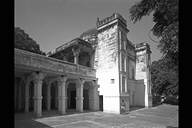
→Plan and photos of each part
VARANASI
Being known as
the most eminent Hindu holy place, Varanasi has not been
connected with a mosque, despite the fact that it was called
Muhammadabad at the time of the 3rd emperor Akbar reign. However,
there remain a few mosques built under the 6th emperor of Mughar
Empire, Aurangzeb and a mosque from the early Muslim reign. Also
a few mausoleums remain, although they are mostly neglected.
As
buildings under Aurangzeb reign, two are famous among tourists,
Chhota Masjid (Small Mosque), is known by its long slender
minaret and is located next to Panchganga Ghat in Ganga.
Bisheshwar Mandil is known as the Golden Temple. The mosques we
introduce here are seen as important as those built in the early
years of Muslim control of South India, but have been rarely
referred to before. (Matsuo Ara)
 |
The meaning of the
common name is "two and a half domes" but
actually it has a single dome with a high drum. It is a
magnificent mosque with a majestic east gate. It is said
that a Hindu inscription from the late 12th century
exists here but this is not confirmed. Rooms extending to
the south and north of the main prayer room have pillars
of Hindu temple style so we can assume that this mosque
was built in the late 12th -13th century. It is still
used for Muslim prayer. It can be said that this is a
structure that should be paid extreme attention to, among
mosques built in the early years of Muslim control of
South Asia. It is situated at the south side of a square
in front of Kashi railway station in Varanasi city.
(Matsuo Ara) →Plan and photos of each part |
 |
This mausoleum is remained near the big iron bridge over the Ganga in Banarasi. Though I did not search the origin of this name, which means "Red Khan ", this can be built during the middle of Mughal Period judging from the construction or the pattern like Kiosks at each corner on the roof, or the treatment for the walls. (Matsuo Ara) →Plan and photos of each part |
 |
This is also in ruins located on the edge of the field near the big iron bridge. It is a square-planned mausoleum which has a dome with the stately octagonal Drum. In my opinion, it is probably older than the tomb of "Lal Khan", therefore it can be dated back to the early Mughal period. (Matsuo Ara) →Plan and photos of each part |